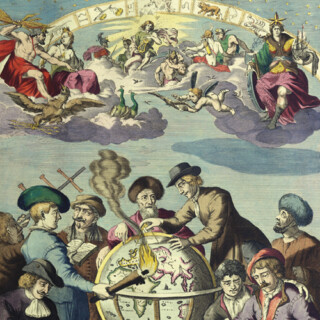The Mariners Mirrour...
Herein also may be understood the exploits lately atchived by the Right Honorable the L. Admiral of England with Her Ma[jes]ties Navie; and some former services don by the worthy Knight S[i]r Fran[cis] Drake.
[London,
J. Charlewood for ?H. Haslop,
1588].
Two parts in one volume. Folio (390 by 265mm). Two engraved titles, engraved coat-of-arms of Sir Christopher Hatton, small engraved radial plate tipped in to A1, 3 engraved plates with volvelles, 45 double-page engraved charts, several charts with early hand-colour, some offsetting to a few charts; contemporary calf, gilt, spine in compartments separated by raised bands, gilt.
390 by 265mm. (15.25 by 10.5 inches).
23908
notes:
"In 1587 the English translation of Waghenaer's 'Speighel der Zeevaert' was commissioned by the Lord Chancellor, Sir Christopher Hatton. The translation was carried out by Anthony Ashley, Clerk of the Privy Council, who used the 1586 Latin edition as a model. New plates were cut by De Bry, Jodocus Hondius, Augustine Ryther, and Johannes Rutlinger" (Koeman).
The maps are some of the earliest engraved in England and the atlas, as well as being the first printed sea...
The maps are some of the earliest engraved in England and the atlas, as well as being the first printed sea...
bibliography:
Koeman, Wag 13; ESTC, S122236; Hind, 'Engraving in England', 151–153; Koeman, 'The history of … Spieghel der Zeevaerdt', Lausanne, 1964; Skelton, 'Bibliographical note' in the facsimile edition, Amsterdam, 1966; Waters, 'Art of navigation', London, 1958; Waters, 'Waghenaer's … influence on English hydrography' in 'Lucas Jansz. Waghenser van Enckhuysen', Enkhulzen, 1984.
provenance:













